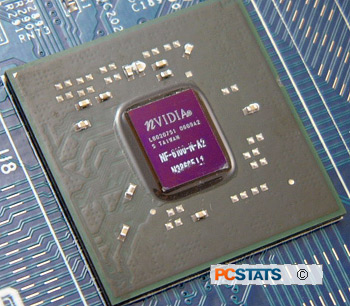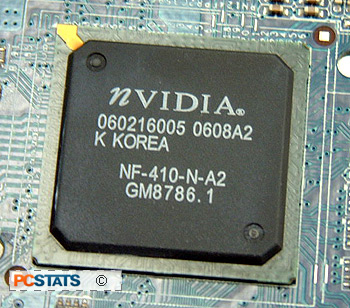The nVidia GeForce 6100 series chipset brings integrated
video to the AMD
Athlon64 in a low cost, fully integrated solution had been lacking for this
stellar platform until its arrival in late 2005. The GeForce 6100 'C51' GPU
has been embraced by cost-concious users and system integrators ever since. It shares 128MB
of memory with the system.
 The Geforce 6100 chipset
is technically a GPU, and that GPU is built by TSMC on the 90 nanometer manufacturing
process. All current socket 939 and socket AM2 AMD Athlon64/X2/FX and
Sempron processors are supported.
The Geforce 6100 chipset
is technically a GPU, and that GPU is built by TSMC on the 90 nanometer manufacturing
process. All current socket 939 and socket AM2 AMD Athlon64/X2/FX and
Sempron processors are supported.
The GeForce 6100 chipset utilizes a 1
GHz 16-bit wide upstream and downstream Hypertransport connection between
itself and the Athlon64 processor.
The GeForce 6100 is a little less feature packed than the
Geforce 6150 model, (the majority of these disparities relate to High Definition
content) and thus does not
support a TV encoder,
TMDS/DVI, 1080p/1080i HD playback, high quality 5x4 video scaling or nVidia
ActiveArmor firewall. Instead, video scaling is pegged at basic quality (2x2),
and MPEG-2/WMV9 playback at standard definition (4:3) video playback.
The Geforce 6100 graphics core operates at a
slightly lower speed than its brethren too, 425 MHz as opposed to 475 MHz. All Geforce
61XX-class chipsets support a total of 18 PCI Express lanes, 16 for the videocard
and two for miscellaneous devices. In addition to the PCI Express x16 graphics
slot, motherboards with a Geforce 6100 chipset are only allocated a single PCI
Express x1 slot, instead of two as with the Geforce 6150.
Here is a chart detailing the different combination of
features pertaining to the Geforce 61XX-series chipsets available on the
market. The Biostar TForce 6100 AM2 motherboard falls under the third
(6100/410), and most basic set of features.
|
NVIDIA GeForce 6150 and NVIDIA nForce
430 |
NVIDIA GeForce 6100 and NVIDIA nForce
430 |
NVIDIA GeForce 6100 and NVIDIA nForce
410 |
| CPU |
Socket 939/AM2 Athlon 64/X2/FX /
Sempron |
| PureVideo |
Yes |
| DirectX 9.0c Shader Model 3.0 Support |
Yes |
| TV Encoder |
Yes |
No |
| TMDS/DVI |
Yes |
No |
| Graphics Clock |
475 MHz |
425 MHz |
| PCI-Express |
(1) x16 (2) x1 |
(1) x16 and (1) x1 |
| MPEG-2/WMV9 Playback |
high-definition (1080p/1080i) |
standard definition |
| Audio |
HDA (Azalia)/AC97 |
| Video Scaling |
high-quality (5x4) |
basic (2x2) |
| SATA/PATA drives |
4/4 |
2/4 |
| SATA speed |
3Gb/s |
| RAID |
0, 1, 0+1, 5 |
0, 1 |
| NVIDIA MediaShield |
Yes |
| NVIDIA ActiveArmor Firewall |
Yes |
No |
| Ethernet |
10/100/1000 |
10/100 |
| USB ports |
8 |
| NVIDIA nTune Utility |
Yes | |
The nVidia GeForce 6100 is dual
chipset solution, and so it is combined with the nforce 410 Southbridge. The
nForce 410 is Serial ATA II compatible (two ports), and can be configured for
RAID modes 0, 1, JBOD. The Southbridge also works with Intel's new Azalia 7.1
channel High Definition Audio codec.
 Connecting the two
motherboard chipsets is second HyperTransport link; this however only runs at
800 MHz with an 8-bit wide upstream/downstream data bus.
Connecting the two
motherboard chipsets is second HyperTransport link; this however only runs at
800 MHz with an 8-bit wide upstream/downstream data bus.
The GeForce 6100 series graphics cards has
two pixel rendering pipelines, so that right away should tell users the onboard
graphics card is best only for casual gaming. It does however support the
DirectX 9.0C standard as well as support for Shader Model 3.0, so the onboard
videocard will work just fine with Microsoft's Vista operating system
'Aeroglass' desktop.
Another nice feature is that the
onboard graphics card is not automatically disabled when using a PCI Express x16
graphics card. Users who need a lot of desktop screen real estate will certainly
appreciate the ability to take advantage of that extra analog monitor
jack.
Perhaps the most important feature of both the
Geforce 6150 and 6100 chipsets is PureVideo, and that's what we'll be looking at
next.
